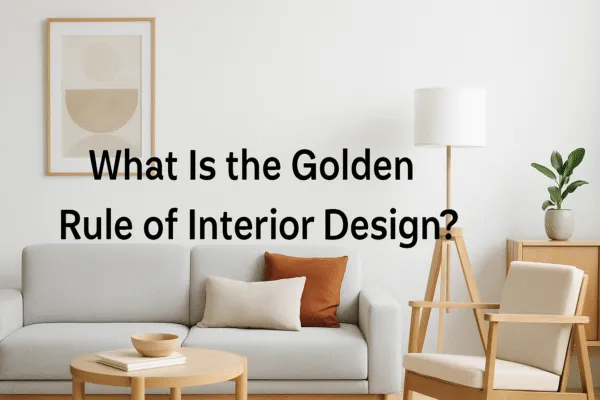
What Is the Golden Rule of Interior Design?
Introduction
Interior design is a field that beautifully balances creativity, functionality, and human psychology. While trends change and styles evolve, one principle remains timeless: the golden rule of interior design. Often associated with balance, proportion, and harmony, this “rule” serves as the foundation for creating spaces that feel naturally comfortable and visually appealing.
In Palm Desert, CA, where homes and commercial spaces often reflect desert elegance blended with modern luxury, hiring a professional Interior Designer in Palm Desert ensures that the golden rule is applied thoughtfully. But what exactly is this rule, and how do designers use it to transform ordinary spaces into extraordinary ones?
Understanding the Golden Rule of Interior Design
The golden rule of interior design is rooted in the concept of balance and proportion. Often linked to the Golden Ratio (1:1.618), a mathematical principle found in art, architecture, and nature, it emphasizes harmony in spatial arrangements.
In practical terms, the golden rule ensures that no element of a room feels too overwhelming or too insignificant. Furniture, colors, textures, and décor should complement one another, creating a unified look that feels both functional and beautiful.
Key Principles Behind the Golden Rule
1. Balance in Space
Balance is the distribution of visual weight within a room. Interior designers create equilibrium by using symmetry, asymmetry, or radial balance.
Symmetry: Matching furniture and décor on opposite sides of a central axis.
Asymmetry: Different but visually balanced objects on either side.
Radial balance: Design elements arranged around a central focal point.
An Interior Designer in Palm Desert often applies balance to open floor plans, where proper distribution of furniture creates flow without clutter.
2. Proportion and Scale
Proportion refers to the size relationship between elements, while scale refers to how objects fit within the space as a whole. For instance:
A large sectional sofa in a small room feels overwhelming.
Small art on a large wall feels underwhelming.
By following the golden ratio, designers ensure all elements feel “just right.”
3. Harmony and Unity
Every element in a design should connect visually. This doesn’t mean everything must match, but rather that colors, textures, and shapes complement one another.
In Palm Desert homes, designers often use earthy tones, natural textures, and desert-inspired accents to create harmony that blends indoor and outdoor living.
4. Rhythm and Flow
Interior spaces should guide the eye naturally. Repetition of patterns, alternating colors, or gradual progression of sizes creates rhythm. For example:
A series of pendant lights decreasing in size.
A color accent repeated across pillows, rugs, and artwork.
5. Focal Points
Every room needs a focal point—a fireplace, artwork, statement furniture, or a scenic window view. The golden rule ensures focal points enhance the design without overpowering it.
Applying the Golden Rule in Palm Desert, CA
Palm Desert’s unique lifestyle blends modern luxury with natural desert beauty. Applying the golden rule here often means:
Designing open floor plans that flow between indoor and outdoor spaces.
Using proportion to highlight large windows and scenic views.
Balancing neutral desert tones with bold accent colors.
Creating focal points like statement lighting or natural stone fireplaces.
Working with an experienced Interior Designer in Palm Desert ensures these principles are customized to each client’s needs while reflecting the region’s elegance.
Why the Golden Rule Matters
Psychological Comfort – Balanced spaces feel calming and organized.
Visual Appeal – Proper scale and proportion create aesthetic harmony.
Functionality – Well-planned layouts improve usability.
Timelessness – Designs based on golden principles outlast fleeting trends.
Golden Rule in Different Aspects of Design
Furniture: Arrange pieces for balance and proportion.
Lighting: Distribute fixtures evenly to avoid dark or overpowering areas.
Colors: Apply the 60-30-10 rule (60% dominant, 30% secondary, 10% accent).
Accessories: Use odd numbers (like grouping three vases) for natural appeal.
The Role of Professional Designers
While anyone can experiment with design, mastering the golden rule requires skill and experience. A professional Interior Designer in Palm Desert not only understands these principles but knows how to tailor them to fit the client’s lifestyle, space, and budget.
Conclusion
The golden rule of interior design is about more than math—it’s about creating spaces that feel balanced, harmonious, and timeless. By applying proportion, balance, and unity, designers craft environments that both inspire and comfort.
For homeowners and businesses in Palm Desert, CA, working with an Interior Designer in Palm Desert ensures that the golden rule is applied with precision and creativity, resulting in interiors that perfectly blend desert charm with modern sophistication.
10 Frequently Asked Questions (FAQs)
1. What is the golden rule in interior design?
It refers to balance, proportion, and harmony—often guided by the golden ratio.
2. Do designers always follow the golden ratio?
Not always, but it provides a strong foundation for timeless design.
3. How is balance achieved in interior design?
Through symmetry, asymmetry, or radial arrangements.
4. What is the 60-30-10 rule in design?
A color principle: 60% dominant color, 30% secondary, 10% accent.
5. Can I apply the golden rule without a designer?
Yes, but a professional ensures it’s applied effectively across all elements.
6. Why does proportion matter?
It prevents furniture or décor from looking too big or too small for the space.
7. Do Palm Desert designers use natural elements?
Yes, many incorporate desert-inspired tones, stone, and wood for harmony.
8. What role do focal points play?
They create visual interest and draw attention without overwhelming the room.
9. Does following the golden rule make a space timeless?
Yes, designs based on balance and harmony rarely go out of style.
10. Why hire an Interior Designer in Palm Desert?
They understand both global design principles and local lifestyle needs, ensuring customized results.



